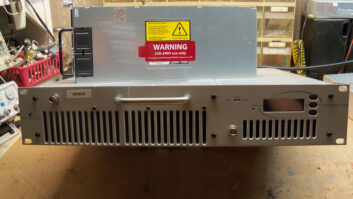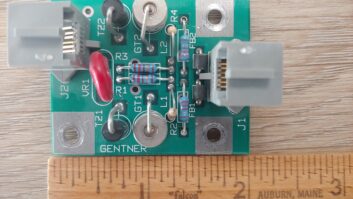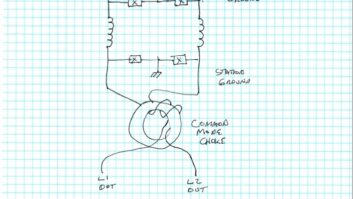Repair or Replace?
Jun 1, 2012 1:00 AM, By Kevin McNamara
While preparing to write this article I noticed that my four-year-old HP color laser printer stopped working; hmmm, coincidence? Maybe. I spent a couple of hours trying to figure out the problem only to discover there was a broken part. The mental conflict begins, the engineer (me), of course, wants to order the part and fix it. This would probably cost about $100 and several hours out of my life. The business owner (me) goes directly to the usual websites to price a replacement unit. This kind of struck home when I think back on my days in a station where the answer would be a little different, I call it general manager logic, goes something like; I go to the manager tell him (or her) X is broken, we can fix it for this much or we can buy a new one for this much.

The older the equipment, the easier the choice is as to repair or replace.
Now most of you already know the answer here, most likely the response will favor whatever costs less, buying the part or buying a new unit. The key difference here is that the manager is generally not valuing your time in this equation, so if the part is $10 and it takes you two weeks to complete, no problem. Just to take this logic to the next level, let”s assume the broken part in question prevents listeners from hearing the station, now the checkbook is open and your time is still not factored into it. Of course if you are billing hourly, this scenario changes slightly, and how much you are going to cost them becomes a huge factor in the decision because the manager now has to write a check to you as well. The point here is simply how people (managers) view an expense. If you are a salaried employee, the cost for you is already fixed and therefore an expense they assume regardless of the work you perform. On the other hand if you charge hourly, the company will view the expense as the cost for the part(s) and the labor (you). This is simply a generalized mindset of an owner or manager in most businesses.
Since the 1970s we have increasingly become a “disposable economy.” What was once considered to be a durable item now has finite lifespan. Manufacturers spend time and money figuring out how to build a product that will fail in a predetermined period of time; this is called planned obsolescence.
Shifts in technology can also cause equipment to need replacing long before it stops working from natural causes. As an example consider the rapid change in physical networking standards over the past 10 years. Much of the networking equipment (wired and wireless) purchased in that same period had to be replaced (in some cases more than once) to maintain compatibility with a new system upgrade. The good news is that the cost to acquire technology has dropped significantly, while offering a far greater range of features.
I purchased my old HP color LaserJet printer (yes the one that just broke) for around $600. It was a good and reliable printer, considered state-of-the-art at the time, however the current equivalent new unit is smaller, uses less power and ink, produces higher resolution, prints faster and prints full duplex out of the box. The price? About $200.00 less than I paid for the old one. This is the reality of the world we live in. Instinctively many of us (especially my fellow boomers) have a hard time justifying a new whatever every few years; however it is hard to deny we love getting the latest technology for a lower price. Using this justification it was a no-brainer for me to buy the new replacement color printer.
– continued on page 2
Repair or Replace?
Jun 1, 2012 1:00 AM, By Kevin McNamara
Making the best decision
Using the aforementioned thought process, the primary consideration would be the equipment in question, its age, the purchase price and “Is it likely to work with emerging technology standards?” These seem obvious but I would also consider the purpose for which equipment was originally designed. I think it is fair to say that most of the mission-critical equipment in a station was designed specifically for broadcast (or similar) applications and as such, is designed with a much higher level of reliability than consumer equipment. It has also been my experience that there is still a robust source of repair parts for the most popular old (and current) broadcast manufacturers, particularly RF equipment, whether those parts were removed from decommissioned equipment, remanufactured or new from third-party sources. Of course for studio and transmitter equipment, this was a good alternative up to about the late 1990s but the reality is that most of you have leaped into the IP/IBOC/digital everything world and all those rotary faders, miles of Belden 8451 and power guzzling transmitters were sold as scrap, so pretty much every aspect of the station is relatively new.
In reality this newer generation of commercial broadcast equipment is expensive, uses proprietary technologies and has very little that can be repaired in the field (at the component level) without the proper training, test equipment and skill. Tech rooms at stations look more like a network server farm than a radio station, mainly because that”s what it is, therefore the overall approach to troubleshooting is at the system level i.e. find out where the error comes from, replace the box and everything is fine. OK, that is a little oversimplified, perhaps, but it accurately represents the trend going forward.
From a system perspective there could be another wrinkle. Does this particular piece of failed equipment utilize or operate over a system that uses a proprietary technology? This was more common with early attempts of digitizing the studio. Fortunately most of those systems were either replaced or upgraded to make them interoperable with other manufacturers’ equipment that uses standard IP protocols. If you are lucky enough to have some of this older non-standard technology, there is probably a stronger case to replace the entire system rather than expending the time and money to fix the junk.
Finally let us not forget Moore”s Law. That was Gordon Moore’s (Intel co-founder) prediction that the densities of semiconductors in an integrated circuit will double every two years. Apparently the theory held true since 1965, however some experts think the trend will slow and we will only see the doubling every three years. Overall I think the case for replacement of broken equipment grows each day.
McNamara is president of Applied Wireless, Cape Coral, FL.
June 2012
The Pick Hits of the 2012 NAB Show, new products from the 2012 NAB Show, KSBJ rebuilds, and Field Reports on the Yellowtec iXm and Aphex HeadPod 4….












